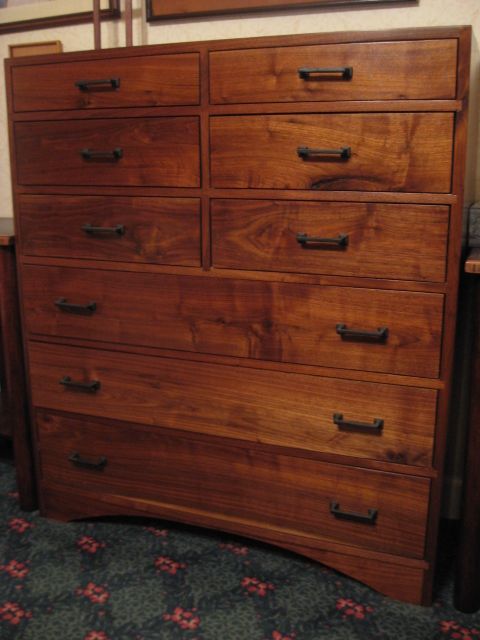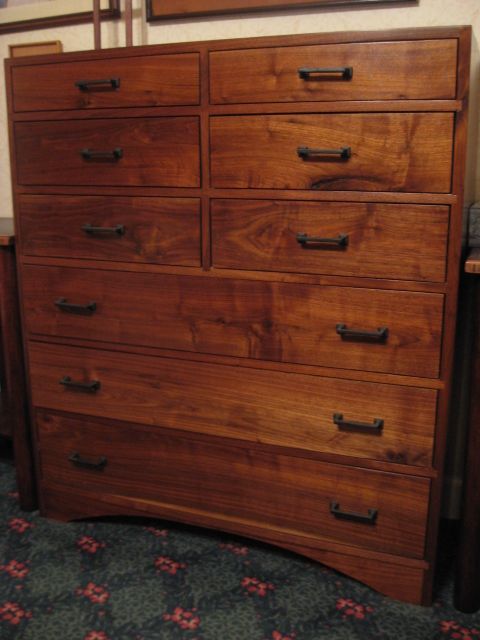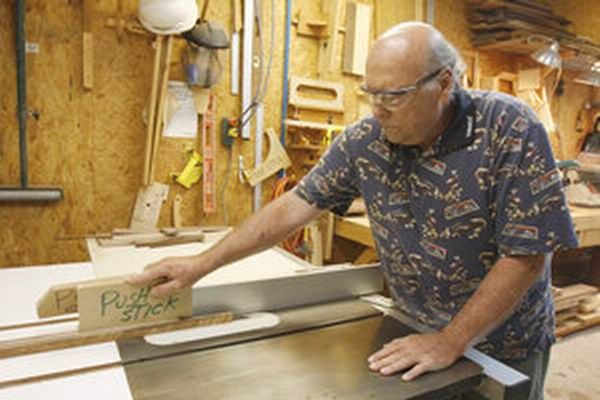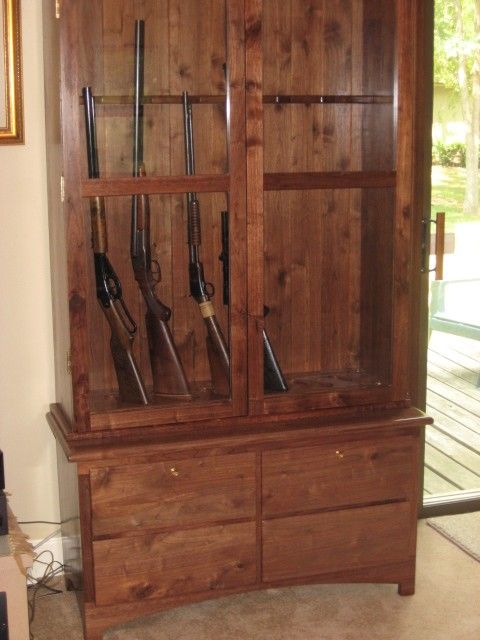
A case piece that Tom built before his vision deteriorated.
Tom Fuller took up woodworking about 10 years ago after moving to Rock Hill, SC toward the end of his construction career. Back then, with one good eye and one bad one, he built a house full of furniture for he and his wife, Riccie. Chests of drawers, a sideboard, several occasional tables and more.
Since then, though, he lost the bad eye and the good one got worse. Detached retina. Corneal transplant. Legally blind is what the doctors say now – 20/300, with more surgery on the horizon.
But Tom is still a woodworker.
He can’t read facial expressions or see the teeth on his tablesaw blade, but he still makes regular trips to his shop in the outbuilding behind his home. His biggest recent project, a gun cabinet for his daughter, was interrupted a couple of times for surgery. It took 2 years to complete.
It might surprise you to learn that Tom’s a power-tool guy. His shop is complete with a tablesaw, jointer, thickness planer, drill press, router table, biscuit joiner and jigsaw. The jigsaw is the one he avoids. In order to follow a line with it, he says, “I have to get my eye and face so close to the blade that sawdust becomes a real problem.”
Tom uses a visor-style magnifier, but still has to get his eye within 2 inches of the scale when setting his tablesaw fence. For cuts that he makes frequently, he’s milled reference blocks for the sake of quick and consistent set-ups.
He’s figured other work-arounds, too. He used to get fits trying to line up the dust-suction holes on his random-orbit sander with the holes on a new sanding disc. Then he found that dowels in a couple of the sander holes worked perfectly as indexing pins, helping him feel his way to a good fit. When he needs to drill a hole, he puts a piece of white tape on the workpiece and marks the spot with a black marker. Then he uses a punch to strike a dimple that he can find with his finger to locate the drill bit.
Among his biggest frustrations – trying to get a two-prong plug into an electrical socket and the fact that “it takes me so long to do things.”
To see more of Tom’s shop and work, check out the story in his local paper, The Rock Hill Herald, or watch the video from the local TV station. If you’re a visually impaired woodworker and you have ideas to share for working safely and quickly, post a comment. Tom is eager to hear from you.
























Comments
This guy is my new hero, absolutely. I stopped riding a motorcycle and being a m/cycle mechanic after an accident left me with a bum right leg and right hip, that is why I wood work now. I cannot imagine anything tearing me out of my shop even though I am just a beginner, so people like this deserve the admiration from people like me. The only thing I would suggest for my new hero Tom is to take out an ad in a local paper for an apprentice, an unpaid intern of sorts that he can have help him and he can guide into the great journey that wood working is. If I lived close to Tom, I would ump at such an opportunity. Thank you for the inspirational article!
I've been legally blind my whole life (20/400 in both eyes) and have been honing my woodworking skills for the last five years or so. I've found that I can do most everything I need to safely, but the frustration comes from the extra time required to do even simple tasks. I always say that it takes twice as much time to be half as accurate...
That tip about the white tape is GOLD... drilling accurate holes has always been extremely difficult for me. Here are some other tricks that I use:
- The flush-trim bit. I have the same problem as described with the jigsaw and bandsaw, so most of the time I'll slowly and carefully create a template using MDF, then tranfer it to the final piece using the router and a flush-trim bit. I have a few templates that I keep around for simple curves and have copied templates from household objects more than once!
- Trust your fingers. The human sense of touch can feel features as small as a thounsandth of an inch. If you need two pieces of stock to be of the same dimensions, line them up and feel. You're going to do a lot of cut-and-fit this way, of course, but this works well in a lot of cases. Do not use your sense of touch to align cutting tools!
- Polarized safety glasses. Depending on your particular visual issue, these could help cut down on glare considerably.
- Technology. There's all kinds of stuff out there that will help with measuring and alignment of cuts. I have more digital gauges than I can count, many of them accurate to a thousandth of an inch or a tenth of a degree. Laser guides work if you can get someone to help align them for you (and if you can see the laser lines. I can't unless the ambient lighting is fairly dark, and operating saws and drill presses in a dark room is Not Recommended.)
My friends and family always worry about safety, as expected. I've had a few close calls like any woodworker, but I still have all of my digits, have never suffered any serious injuries, and have never hurt myself in a way I can attribute to my eyesight (knock on proverbial wood.) Still, it would be foolish to deny that this craft is no more dangerous for a visually-impired person than for someone with normal sight.
Besides all of the usual rules, here are some other tips:
- If something feels dangerous, that's probably because it is. If you feel that you may not be able to safely do a thing because of your eyesight, DON'T DO IT! This goes double if your vision loss is recent... you may not know your limitations. ALWAYS ask for help if you think your eyesight could create a dangerous situation.
- Face shield. You'll see face shields used by lathe operators all of the time... they work GREAT for close up work. Your face shouldn't need to be near the tool anyway, but sometimes it's necessary (the above jigsaw example, freehand router work, etc..)
- Zero clearance insert. This is really a must for anyone using a table saw, but it goes double if your eyesight is impaired. You may not see small pieces nearing the opening in a standard insert, and you don't want them flying back at you.
- Keep a clean work area! Besides tripping over junk scattered aroudn your workshop, you may not see little tools and parts near the "business end" of your power tools. In my first few weeks as a woodworker, I somehow managed to get a tape measure behind the fence of my mitre saw, didn't see it, and nailed it with the blade. (I still keep the mauled and useless tape measure around as a reminder.) You MUST be diligent about keeping track of where your equipment is!
- Safety your gear. When not using a bladed tool, powered or otherwise, make it safe! Put sheaths around your chisels, cover your hand saws, and lower the blade of your table saw when not in use. I like to lower the blade of the TS, then move the fence over top of the throat insert.
- Use your other senses. You'll be able to hear changes in motor pitch and feel vibrations when something starts to go wrong.
You'll find the little tricks that make you more productive over time, but safety is one thing that you just can't learn by trial and error. Best of luck, and BE CAREFUL!
Log in or create an account to post a comment.
Sign up Log in